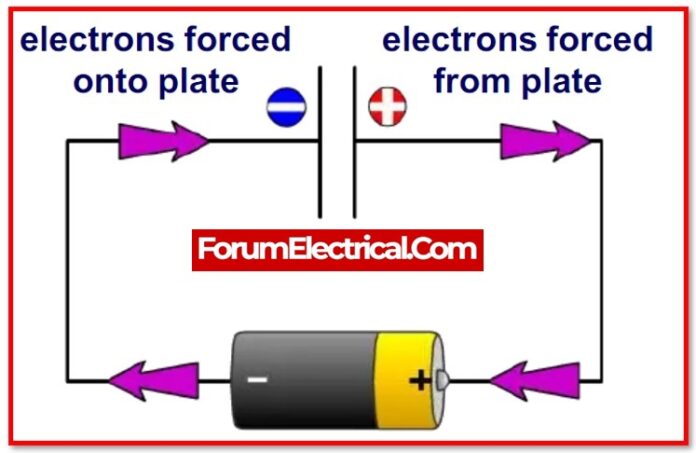What is Capacitor?
A capacitor is a type of electronic component found in the circuits of electronic devices including radios, computers, and more. Energy can be temporarily stored in capacitors and supplied as required in circuits. Capacitance is the characteristic of the capacitor that defines its energy-storing capacity.

An electric field is generated inside of a capacitor whenever energy is stored inside. The electric field can be linked to the energy that has been stored. To be accurate, an electric field is correlated with energy.The analysis of capacitors & capacitance results to a very important aspect of electric fields i.e., electric field energy.
Capacitance
When a conductor is continually given charge, the potential of the conductor continues to increase. Thus:
Charge (Q) is directly proportional to potential (V)
Or
Q = CV
Where,
C – proportionality constant, & its value is referred to as the capacity (or) capacitance of the conductor.
And it is expressed as
C = Q / V
A conductor’s capacitance can be defined as the ratio of the charge that is on the conductor to the potential of the conductor.
The value of proportionality constant C is determined based on the dimensions & shape of the conducting object, the characteristics of the medium that surrounds the conducting object, and the relative locations of any nearby charges all have an effect.
On the other end, it is not dependent on the material that the conductor
From the above equations,
Q = C (or) C = Q
The amount of the charge that is required to bring a conductor’s potential up to unity is therefore equivalent to the capacitance of the conductor.
The SI unit of the capacitance is denoted by the symbol farad (F).
1 (Farad) = 1 (Coulomb)/1(Volt)
Charging and Discharging of the Capacitors
Charging of the Capacitor

When capacitor is linked to a battery, a positive charge will appear on one plate of the capacitor, while a negative charge will appear on the other plate. In the end, the electromotive force of the battery is equal to the potential difference that exists between the plates. The operation as a whole requires some time, during which there is a flow of electric current between the connecting wires & the battery.
q= ЄC(1-e-t/CR)
Where,
q -Charge on the capacitor at time t,
CR – Time Constant,
ϵ- EMF of the battery

Current in a charging RC circuit
I =(V/R)e-t/Ʈ

During the charging process, time constant is defined as the time it takes for the current to decrease to 37% of its initial value or the voltage across charging capacitor to rise to 63% of its maximum voltage.
Discharging of the Capacitor
When a charged body (charged) comes into contact with a body that is not charged, the electric charges on the charged body transfer to the body that is not charged, and this process continues until the charges on both the bodies are equal. This process will continue until there is an equal amount of charge on both bodies. This process is referred to as the “discharge of capacitor,”.

The capacitor will be discharged if the plates of the charged capacitor (fully charged) are connected through with a conducting wire to another conducting wire.
q= Qe-t/CR
where,
q – Charge on the capacitor at time t,
Q – Charge on the capacitor at time t=0 &
CR – Time Constant

Current in a discharging RC circuit
I =(V0/R)e-t/Ʈ
Where,
V0-Intial Voltage

During the discharging process, the time constant is defined as the time it takes for the voltage across the capacitor and the current in the circuit to decay exponentially, with time falling to 37% of its initial value.
What is Time Constant (CR)?
Time is the primary factor that determines CR’s dimensions.
In addition, if CR is less than one (CR < 1), Q will arrive at its final value quickly, but if CR is greater than one (CR > 1), the process will proceed slowly. Therefore, the rate at which capacitor charges (or) discharges itself is determined by CR, which is a resistance.
Because of this, the quantity CR is referred to as the time constant, or more accurately – capacitive time constant of the circuit. This is because CR represents the amount of time that the circuit takes to complete a cycle.
Why should capacitors be discharged?
Capacitors are devices that stores electricity & can provide a painful shock if they are touched while they are still charged. Because of this, it should be discharged before touching them.
After the electricity has stopped flowing through the circuit, they have the ability to store the current in them for up to a few minutes. Because of this, it is necessary to always discharge them prior working.









